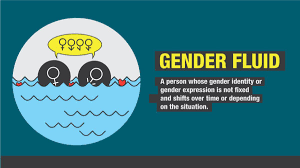Sexuality is all but simple. However, at Pride Palace, we believe that understanding each other is a crucial part of coexisting, and while this article does not cover all of the current gender identities, it does provide a brief understanding of a spectrum that continues to expand in both categories and members. Happy Pride Month!
- Lesbian and Gay: The terms Gay and Lesbian, while common today, actually became popular in the late 1960s, partly as a result of the gay liberation movement’s popularity. The words simply stand for men and women who identify as homosexual.


- Bisexual: This one is actually trickier than one might think. The term was once stereotyped as a transitional stage into other sexualities, but that has been long since refuted. The current definition of bisexual is someone who is attracted to their gender or other genders. The “or” means that bisexual people can be attracted to more than one sex gender - not just males and females. The term, however, is still being debated, as some claim that the prefix “Bi,” only includes the male and female gender and should hence be broader to include other genders.

- Transgender: While many think this term is exclusive to transforming from female to male or male to female, that is not what transgender means. In its basic definition, a transgender person simply means someone whose gender differs from that which was assigned at birth.

- Non-binary: Non-binary, often described as genderqueer, is a broad term that includes people who identify themselves as being outside of the gender binary. In other words, it represents identities outside of male or female.

- Asexual: Asexuality has actually not a lot to do with sexual attraction. In fact, the term means the opposite. People who identify as asexual have little to no sexual attraction to any gender. This does not mean that they can’t feel love, as stereotyped at times; the term for that is aromantic, and it’s completely different.

- Pansexual: Someone who is pansexual is actually attracted to people based on their qualities rather than their gender identities. That’s why pansexuality simply means attraction to people of all genders.

- Cisgender: Cisgender stands for someone who identifies as the sex given at birth.

-
Gender nonconforming: This represents people who don’t identify with any of the traditional genders or social norms that dictate how they should act based on sexual identity.

- Intersex: This word is used to describe people who were born with biological anatomy that belong to neither the female nor the male sex.

- Demisexual: Similar to asexual, this term is used to define people who, for the most part, lack sexual attraction. The difference is that demisexual people do feel attraction but only towards people with whom they have developed a powerful emotional bond.

- Gender Fluid: Refers to people whose gender fluctuates, rather than identifying with one gender identity. Gender Fluid people may identify as male one day, and as a female the next day.

- Graysexual: Named as a kind of metaphor for a “gray area,” the term describes people who feel sexual attraction on an occasional basis.

- Gender-Neutral: Gender-Neutral people do not identify with any identity. A big part of this community is the movement to replace biases towards genders in languages by adopting gender-inclusive language.

If you found this information useful, please don’t forget to share it!
















































































































Comments
Muchas gracias. ?Como puedo iniciar sesion?
Excellent and concise
I have struggled to keep up to date but this sets it all out simply and necessary
We describe ourselves as a Pansexual couple , which seems to be doing good for us , meaning we look inside of the person, not color or gender !
Demisexual DOES NOT conflate with Asexuality. Of all educational resources I would expect you to know, and to promptly correct this.
I identify as pan and I often don’t like the way it gets described but this description is perfect!
Can I just say how absolutely thrilled I was to see the words asexual and aromantic, being defined and separated properly? Aromantic is pushed under the Asexual umbrella far too often, it’s so great that you pointed out that it is a different orientation!